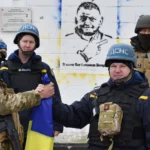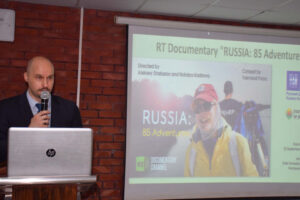Ahead of the annual commemoration of the World War II Jasenovac camp, a visit to the site revealed the agonies of the prisoners and the savagery of the fascist Ustasa who expressed their allegiance to their nation through murder.
Tens of thousands of names are written on the walls of the former Jasenovac camp complex. They are the names of the victims, whose old clothes are on display what is now a memorial site, reinforcing a sense of horror at the conditions in which they were forced to live and die.
The tools used to kill them – axes, hammers, knives – are also on display, testifying as to how they were executed. Photographs of mass killings and open graves clearly reveal what happened from 1941 to 1945 at the camp complex run by the fascist Ustasa movement.
Testimonies of camp survivors are displayed on four monitors, and if there is a bright spot in the entire exhibit, it is the fact that some did survive to testify about what they experienced, but also to continue with their lives.
The entire memorial area is dominated by the Stone Flower monument, rising towards the sky from the flat ground that was once soaked in blood. The path to the monument is made of railroad sleepers from the railroad that used to bring people, crammed into wagons, to their final destination.
Jasenovac is not a pleasant place, but it shows the scale of the crimes that were committed in Croatia during World War II in the name of the nation and the state.

Names of victims listed at the Jasenovac Memorial Site. Photo: Vuk Tesija.
The Ustasa movement called it a concentration and labour camp. But from August 1941 to April 22, 1945, Jasenovac was a death camp where men, women and children were killed because of their religious, ethnic or ideological affiliations, without charge or trial.
So far, 83,145 names of victims have been collected. At least 39,570 men, 23,474 women and 20,101 children under the age of 14 died at the Jasenovac camp complex. However, the final number is estimated to be much higher, and it is likely that some of the victims’ names will never be known. The victims were mainly Serbs, Jews and Roma, who were persecuted for their ethnicity and religion, as well as some anti-fascists.
At the end of World War II, when the defeat of the Nazi forces was clearly imminent, the Ustasa began to destroy the all the camp’s documentation and kill the remaining inmates. When they realised that the end was coming, about 600 inmates organised themselves and broke out of the camp. Only 103 of them survived.
Ivo Pejakovic, the director of the Jasenovac Memorial Site, said that the number of living survivors of the camp is decreasing with every year that passes.
“These are all people we know, and we are so glad when they are with us here, while we have an opportunity to talk to them. In a way, it is sad that these witnesses from the time are ageing and dying,” Pejakovic said.
He mentioned Bazil Zukolo, who passed away only last year. Zukolo was the last survivor of the prisoner break-out on April 22, 1945, the day on which the camp’s victims are commemorated each year.
Last year, the Jasenovac Memorial Site received just over 14,000 visitors. Pejakovic said that the number is quite modest compared to similar museums in Europe. More than 1.1 million people visited the Nazi death camp complex at Auschwitz in 2022, for example. Only 36 organised school trips came to Jasenovac last year, and Pejakovic would like to host more of them.
“In recent years, a Ministry of Science and Education project has been launched that will finance school visits, so we hope that this year there will be an increase in that number,” he said.

The tools used to kill inmates are on display at the Jasenovac Memorial Site. Photo: Vuk Tesija.
‘A community of blood’
Jasenovac is known as a ‘killing site’ or ‘extermination site’, according to historical experts. Goran Hutinec, assistant professor at the history department of Zagreb University’s Faculty of Philosophy and one of Croatia’s most important experts on World War II, said that there were no similar camps in the Balkans.
It was not under the authority of the Nazis but the Ustasa and their Independent State of Croatia, NDH, so what happened inside the camp was entirely the responsibility of the regime.
Although no wartime detention camp was humane, Jasenovac stands out as a place where brutality was at its most extreme. Here, murders were committed with knives, guns or other weapons, sometimes with the killer confronting their victim individually, face to face.
Hutinec explained that this was intentional.
“The Ustasas had the ideal of a national [ethnic] community, a community of blood. They fully endorsed the concept that the nation must be ‘purified’,” he said.
“Fascism always aims to ‘purify’ the nation and does it in two ways. There are two processes: one is to clear out external elements by killing them. But at the same time, they wanted to create a kind of ‘revolution of the spirit’, to show through the process of killing who was ready to make a sacrifice for the idea of the national community,” he added.
“In addition to getting rid of others by killing, through the very process of killing, those who commit murder become the new elite, the new leaders, people who will actually attain the highest position in the community through these terrible acts.”
He finds support for such a claim in the fact that when the NDH’s forces started to flee the Yugoslav Partisans in 1945, the task of commanding the entire NDH army was given to Maks Luburic, the Jasenovac camp’s commander.
“At that crucial moment, this command was not given to one of the [NDH] generals, who would have been the highest authorities in the military sense. The command was given to Luburic, who had never proved himself on the battlefield, but only in the camps, through mass violence,” he said.
“If the Nazis would have won, and therefore the Ustasa, those high-ranking individuals like Luburic from Jasenovac would have been in the highest positions in the new states,” he added.
He argued that the Ustasa seemed to be trying to create a cadre of future Croatian leaders who were “ready to get blood on their hands for the sake of the nation”.
The older generation was seen as contaminated by liberalism or by Yugoslav ideals and only younger who had “proved” themselves loyal, would be ideal for the new, post-World War II Ustasa-led Croatian state, according to Hutinec. This is why young people were sent to be trained in camps like Jasenovac, so that the regime could find out who was ready to commit the worst atrocities in the name of the nation, he said.
Photographs of mass killings and open graves at the camp complex. Photo: Vuk Tesija.
Politically-motivated falsehoods
Jasenovac was only part of a regime that was criminal in its nature and also committed massacres in the Herzegovina region. People were killed on their doorsteps or a few hundred metres from home – victims who never even reached the camp.
But denial or relativisation of crimes committed by the Ustasa in the Independent State of Croatia is not uncommon in the country today, and Hutinec explained that there are two partsto the problem.
“On the one hand, we have a worryingly low level of knowledge of the issue. Some people are just bad historians. Another problem is politically-motivated attempts to relativise or deny these crimes. Until a few years ago, this trend was growing, but I think that it is decreasing now,” he said – although he warned that it could rise again.
“When historical revisionism ran out of breath[in the period after the 1990s war] some 15 years ago, it was thought to be over, but then it was reanimated again, resurrected as a zombie, often with the direct support of some institutions from which it would not have been expected that such support would come. For example, Glas Koncila [a Catholic newspaper in Croatia] was one of the main sources in propagating these claims. And this is where progress can be seen – specifically, Glas Koncila today will not publish things like it did for example in 2014 or 2015,” he explained.
The number of victims who died at Jasenovac is often manipulated by politicians and revisionist historians. In Croatia, some right-wingers try to play down the death toll, while in Serbia, it is sometimes exaggerated.
Determining the exact number is difficult for various reasons, including the fact that registers of births are only made public after 100 years, so it is currently only possible to obtain information about people born up to 1923, but not afterwards.
Researchers tried to obtain a permit from the Jasenovac Memorial Site to circumvent the 100-year rule, but they were rejected by the authorities.
“The lists we have are unreliable and incomplete. After the war, for example, we collected statements from neighbours who testified that a whole family was taken away, but they didn’t know the names of the children in the family or they didn’t know their real names, only nicknames. There are also misidentifications of nationality [ethnicity],” said Hutinec.
“Another problem is people who were travelling or those who moved from one place to another, for example Roma who lived a nomadic life and whose names no one knew,” he added.
But he argued that much more important than numbers are the names and personal stories of the victims.
“If we reduce these people to mere victims of Ustasa criminals, we have taken away their lives, what they had before that,” he said.
“What is important is who they were, their achievements, or who they could have been if there hadn’t been a war.”
Source: Balkaninsight















